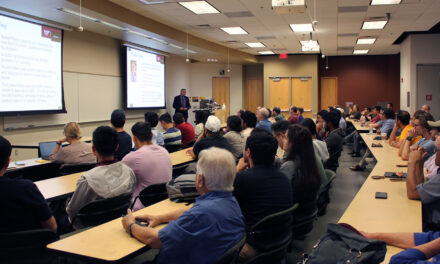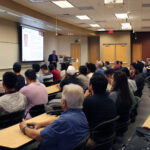
Securing the wireless spectrum
ASU researcher Yanchao Zhang leads development of solutions to improve wireless network dynamic spectrum sharing to ensure security and privacy

The number of devices using wireless communications networks for telephone calls, texting, data and more has grown from 336 million in 2013 to 523 million in 2022, according to data from U.S. wireless communications industry representative group CTIA. As the number of devices increases, wireless providers face increasing risks of slowed down network speeds and unreliable service.
Wireless communications devices operate on a limited set of radio frequencies, which aren’t enough to go around for an increasing number of users. Network providers have an emerging technological trick to overcome the limitation known as dynamic spectrum sharing, or DSS.
DSS uses automated technology known as a spectrum access system, or SAS. The technology uses a combination of dedicated spectrum sensors deployed over large geographic areas and smaller crowdsourced sensors integrated into consumer electronics to gauge usage levels of existing frequencies. SAS then chooses one for a device to use that will keep wireless communications flowing efficiently.
“Picture the wireless spectrum as a vast network of roads, with devices acting as various vehicles traversing these paths,” says Yanchao Zhang, a professor of electrical engineering in the Ira A. Fulton Schools of Engineering at Arizona State University. “Spectrum sensors in wireless communications infrastructure and electronic devices function like traffic monitoring devices, gauging the flow of data across specific segments of this electronic highway. Just as traffic sensors placed along roads collect information on vehicle movements at various points, these spectrum sensors are instrumental in assessing the wireless ‘traffic’ in their geographic areas.”
Zhang, a faculty member in the School of Electrical, Computer and Energy Engineering, part of the Fulton Schools, says feedback from the crowdsourced spectrum sensors, which are integrated into DSS-capable smartphones and other wireless devices, collect data similar to how map apps submit GPS data to update traffic conditions. Due to their wide distribution and lack of strong security, both dedicated and crowdsourced spectrum sensors present a problem, despite being necessary for full uptake of DSS systems: They’re a weak spot hackers can exploit to wreak havoc on wireless networks.
Zhang aims to bolster DSS systems’ defenses against would-be troublemakers — thus solving security issues by developing an artificial intelligence-powered SAS he calls TrustSAS.
TrustSAS is the secret to wireless success
Potential problems that can plague networks using distributed spectrum sensors include spreading fake sensor data and causing devices to slow down data transmission or bring transmission to a halt due to using the wrong frequencies. Other problems involve hackers accessing wireless communications networks, such as those from cell phone providers, and leaks of device users’ location data to malicious entities.
“My research group specializes in cybersecurity and privacy research across diverse wireless and mobile systems, encompassing DSS technology,” Zhang says. “Given that security and privacy issues represent the primary obstacles to widespread deployment and adoption of DSS systems, I am driven by the imperative to address these challenges.”
Zhang and his collaborators, including University of Delaware Daniel L. Chester Mid-Career Professor in Computer and Information Sciences Rui Zhang, are focusing their research efforts on four areas to create TrustSAS and enable widespread DSS adoption.
The first area focuses on developing a tool known as VeriSS, which uses a subset of machine learning called graph neural networks to verify that data transmitted by sensors is reliable. The second area uses VeriSS to build TrustSML, which enables wireless network operators to quickly locate those misusing the network and take decisive action against them.
For the third area, the researchers will develop PriCCS, a tool operated by a wireless network operator that will preserve crowdsourced sensor users’ privacy while quickly assigning spectrum frequencies through DSS in a cost-effective manner. Finally, the team will validate the project’s findings through prototyping and testing the technology by producing needed equipment, assuring it works beyond theoretical applications.
The TrustSAS project is sponsored by the U.S. National Science Foundation and is part of the work conducted by ASU’s U.S. Department of Defense-funded Center of Excellence in Future Generation Wireless Technology, or FutureG Center of Excellence, led by Yanchao Zhang. The center’s research is aimed at enhancing national security by producing advances in wireless technologies.
Collaboration and hands-on learning to improve wireless networks
The TrustSAS project offers many opportunities for students. Doctoral students are assisting in the project’s research, and master’s degree and undergraduate students can participate through special courses and Fulton Schools programs such as the Fulton Undergraduate Research Initiative, or FURI, and Master’s Opportunity for Research in Engineering, or MORE.
In addition, findings from the course will be incorporated into graduate-level electrical engineering courses such as EEE 559 Wireless Networks and EEE 585 Security and Privacy in Networked Systems, ensuring content in ASU’s wireless network courses will remain up to date.
Rui Zhang, who was Yanchao Zhang’s doctoral student at ASU, joined the project after continuing to refine his research in privacy and security in DSS systems since his graduation in 2013. Rui Zhang is focusing on the development of PriCCS.
“Collaborating with Yanchao on numerous projects has consistently been a delight, and I am sure that this project will uphold that tradition,” Rui Zhang says. “Over the years, I have learned a lot from his visionary guidance, expertise, dedication and strong leadership.”
Beyond TrustSAS, he says he is eager to engage in future collaborations with the FutureG Center of Excellence to pursue further advances in wireless security and privacy.



































